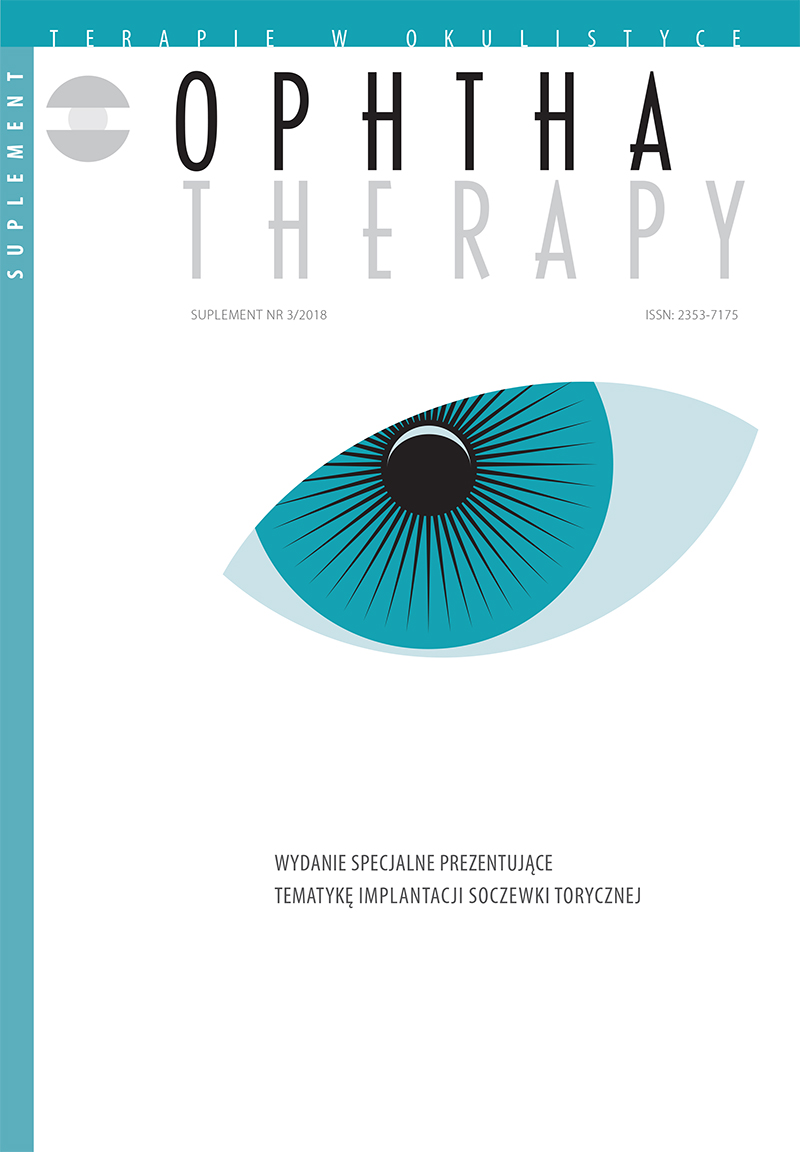The role of the Barrett calculator and the Verion™ system in the qualification, planning and support of the surgeon during cataract surgery with implantation of toric intraocular lenses
Main Article Content
Abstract
The Barrett calculator is a modern intraocular lens calculation formula which measure the refractive power of the intraocular lens taking into account, in addition to the standard parameters (keratometry, axial length), predictable postoperative intraocular lens position, surgically induced astigmatism and the parameters of posterior curvature of the cornea. The keratometry of the posterior corneal surface is indirectly calculated based on the depth of the anterior chamber. This is reflected in a reduction in residual astigmatism after cataract surgery. The Verion™ system provides assistance at every stage of the cataract operation. A measuring unit can accurately evaluate keratometry, pupilometry and take a high resolution picture of anterior segment of the eyeball. A unit allows to plan each stage of the procedure, among others location of the main cut, lateral cuts, size of the capsulorexia and the place of intraocular lens within capsules. During cataract surgery Verion™ displays all the different stages of the procedure and the axis of the toric intraocular lens in the eyepiece of the surgeon. Thanks to that it is unnecessary to mark the cornea of the patient before the procedure and enables a better accuracy of the position of the intraocular implant.
Downloads
Article Details

This work is licensed under a Creative Commons Attribution-NonCommercial-NoDerivatives 4.0 International License.
Copyright: © Medical Education sp. z o.o. License allowing third parties to copy and redistribute the material in any medium or format and to remix, transform, and build upon the material, provided the original work is properly cited and states its license.
Address reprint requests to: Medical Education, Marcin Kuźma (marcin.kuzma@mededu.pl)
References
2. Kane JX, Van Heerden A, Atik A et al. Intraocular lens power formula accuracy: Comparison of 7 formulas. J Cataract Refract Surg. 2016; 42(10): 1490-500.
3. Kessel L, Andresen J, Tendal B et al. Toric Intraocular Lenses in the Correction of Astigmatism During Cataract Surgery: A Systematic Review and Meta-analysis. Ophthalmology. 2016; 123(2): 275-86.
4. Gundersen KG, Potvin R. Clinical outcomes with toric intraocular lenses planned using an optical low coherence reflectometry ocular biometer with a new toric calculator. Clin Ophthalmol. 2016; 10: 2141-7.
5. Kern C, Kortüm K, Müller M et al. Comparison of Two Toric IOL Calculation Methods. J Ophthalmol. 2018; 2018: 2840246.
6. Ferreira TB, Ribeiro P, Ribeiro FJ et al. Comparison of astigmatic prediction errors associated with new calculation methods for toric intraocular lenses. J Cataract Refract Surg. 2017; 43(3): 340-7.
7. Nanavaty MA, Bedi KK, Ali S. Toric Intraocular Lenses Versus Peripheral Corneal Relaxing Incisions for Astigmatism Between 0.75 and 2.5 Diopters During Cataract Surgery. Am J Ophthalmol. 2017; 180: 165-77.
8. Savini G, Nćser K, Schiano-Lomoriello D et al. Optimized keratometry and total corneal astigmatism for toric intraocular lens calculation. J Cataract Refract Surg. 2017; 43(9): 1140-8.
9. Cornut T, Touboul D, Rouglan S et al. Refractive outcomes and precision in toric intraocular lens alignment using an automated alignment system. J Fr Ophtalmol. 2018; 41(4): 291-301.
10. Fu Y, Yu X, Savini G et al. Assessment of Corneal Keratometric and Astigmatism Measurements Using Verion System and Other Instruments in Cataract Patient. Curr Eye Res. 2018; 11 [Epub ahead of print].

